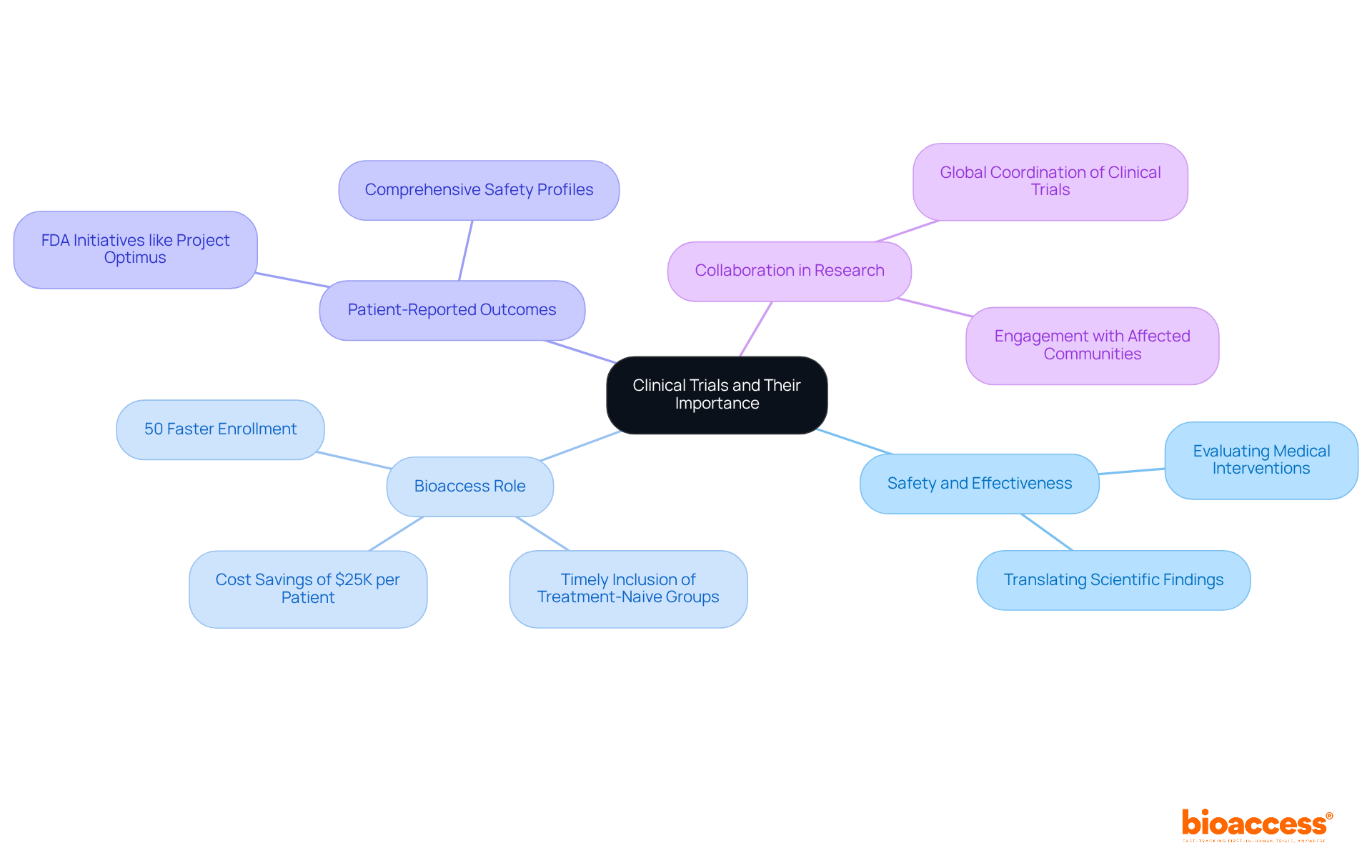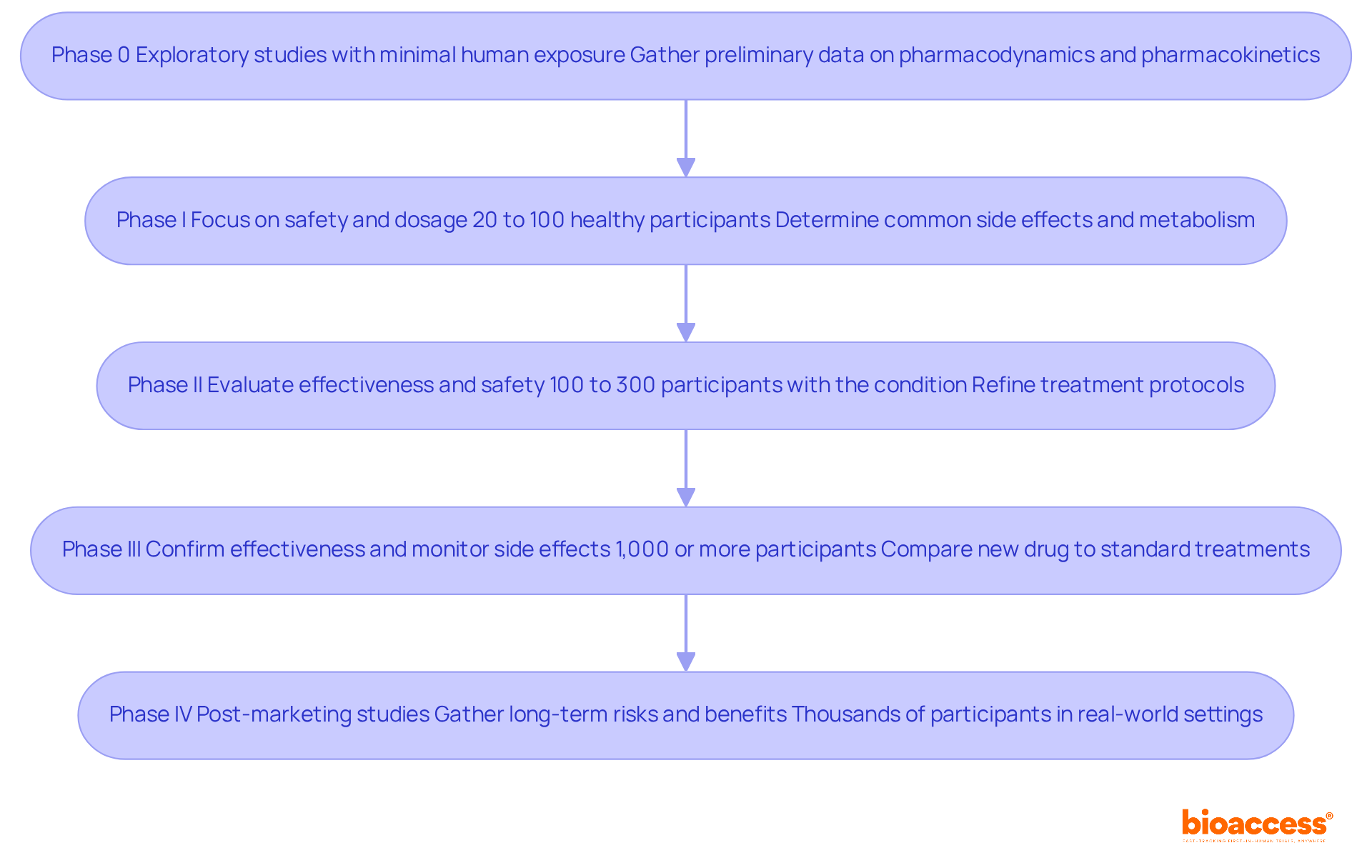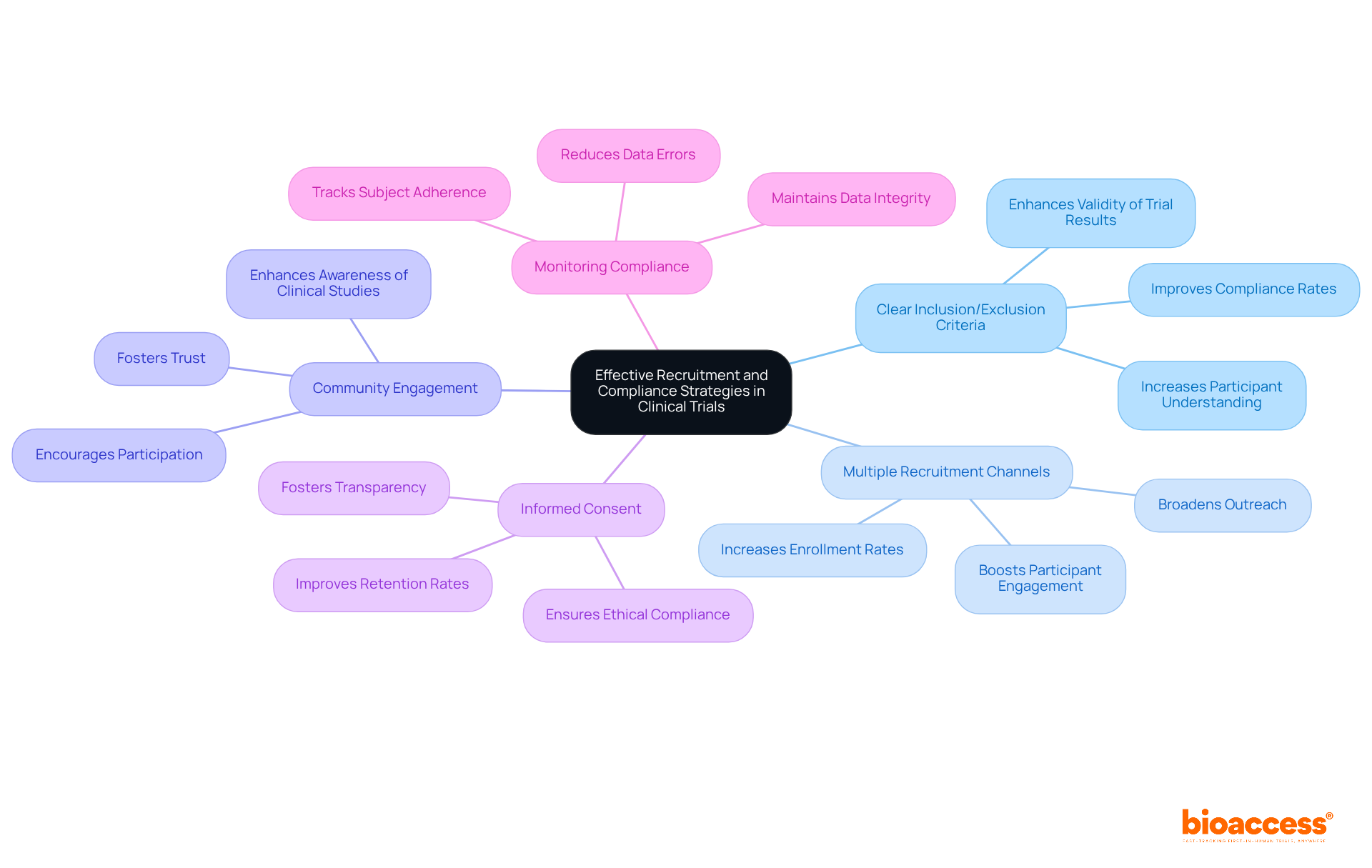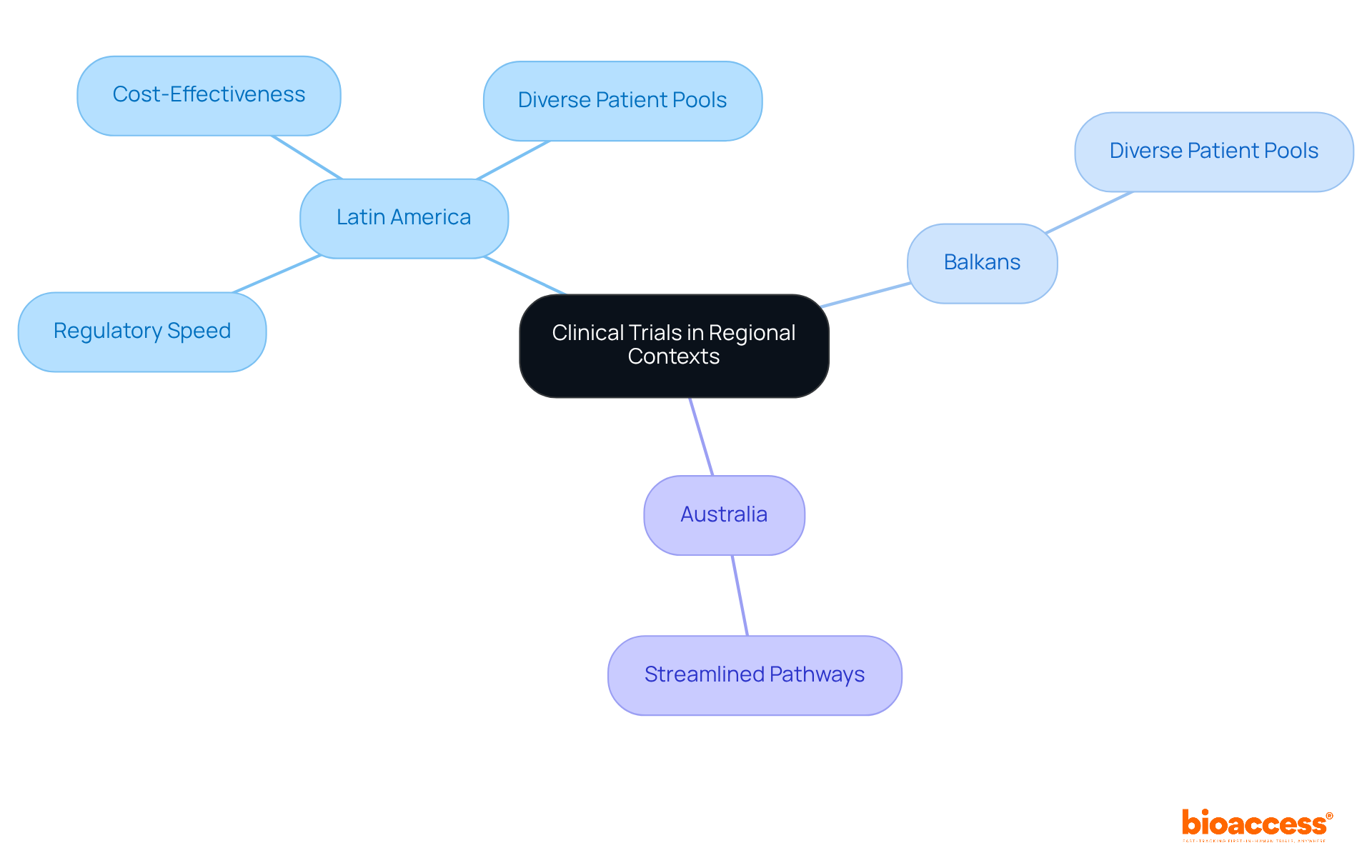


This article delves into the phases, strategies, and regional advantages of IMP clinical trials, underscoring their vital role in assessing the safety and effectiveness of medical interventions. It begins by outlining the structured phases of clinical trials, which are essential for ensuring rigorous evaluation. Effective recruitment and compliance strategies are highlighted as crucial components that can significantly impact trial outcomes.
Regions such as Latin America, the Balkans, and Australia present unique benefits that enhance the efficiency and cost-effectiveness of these trials. For instance, these areas often provide diverse patient populations and streamlined regulatory processes, which can lead to faster recruitment and data collection. This ultimately supports quicker access to new therapies, a critical factor in today’s fast-paced medical landscape.
In summary, the collaboration between various stakeholders in clinical research is paramount. By leveraging the advantages offered by specific regions and implementing effective strategies, the clinical trial process can be optimized, paving the way for innovative medical solutions. As we move forward, it is essential to consider how these insights can be applied to overcome existing challenges in the field.
The landscape of medical research is increasingly shaped by the complex processes of clinical trials, which serve as the backbone for validating new therapies. These trials not only ensure the safety and efficacy of medical interventions but also drive innovation in healthcare. However, with the challenges of recruiting participants and navigating regulatory landscapes, researchers must consider: how can they optimize their strategies to enhance trial outcomes? This article explores the phases of clinical trials, effective recruitment techniques, and the advantages of conducting studies in regions like Latin America, the Balkans, and Australia. By offering insights into these areas, we aim to illuminate pathways that could transform the future of medical research.
Imp clinical trials serve as organized inquiries aimed at evaluating the safety and effectiveness of medical interventions, such as medications, devices, and treatment protocols. These experiments are vital for translating scientific findings into practical medical applications, particularly through an imp clinical trial to ensure that new therapies are both effective and safe for human use. By adhering to strict protocols and regulatory standards, research studies enrich the medical knowledge base, ultimately improving outcomes for individuals and fostering healthcare innovation.
Consider the role of bioaccess in this landscape: it accelerates clinical studies by achieving participant enrollment 50% faster than Western locations. This efficiency facilitates the timely inclusion of treatment-naive cardiology or neurology groups, enhancing the recruitment process significantly. Moreover, it leads to substantial cost savings of $25K per patient with FDA-ready data, eliminating the need for rework and delays.
The incorporation of patient-reported outcomes (PROs) into early-phase studies is increasingly essential, as highlighted by FDA initiatives like Project Optimus, which aim to provide comprehensive safety profiles. Without imp clinical trials, the medical community would lack the critical evidence necessary to support new treatments, highlighting their indispensable role in medical research and development.
In summary, collaboration in clinical research is paramount. As we navigate the complexities of the Medtech landscape, embracing innovative approaches like those offered by bioaccess can pave the way for more efficient and effective imp clinical trials.

Clinical trials are systematically structured into several phases, each serving a specific purpose in the development of new therapies:
Phase 0: These exploratory studies involve minimal human exposure to the drug, primarily aimed at gathering preliminary data on pharmacodynamics and pharmacokinetics.
Phase I: This phase focuses on safety, determining the drug's most common side effects and its metabolism and excretion. Typically involving 20 to 100 healthy participants, Phase I studies are essential for determining safe dosage ranges and observing side effects. Successful examples from this phase often set the stage for further development.
Phase II: Focused on evaluating the drug's effectiveness and further examining its safety, Phase II studies engage 100 to 300 individuals who have the condition the drug aims to address. This phase is where researchers refine treatment protocols and determine if the new therapy shows real promise, with a focus on both effectiveness and short-term side effects.
Phase III: Conducted on large populations, Phase III studies confirm effectiveness, monitor side effects, and compare the new drug to standard treatments. These studies usually include 1,000 or more participants and offer the most convincing evidence for FDA authorization. Successful completion of this phase is often a prerequisite for regulatory approval, making it a critical step in the clinical trial process. With bioaccess®, organizations can achieve 50% faster participant enrollment, significantly reducing the time to market and enhancing the likelihood of regulatory success.
Phase IV: After a drug has received market approval, Phase IV studies are conducted to gather additional information about its long-term risks, benefits, and optimal use in the general population. These post-marketing studies involve thousands of individuals and focus on real-world applications, ensuring ongoing monitoring of the treatment's safety and effectiveness.
Each phase is crucial for guaranteeing that only safe and effective treatments reach the market, which is vital for conducting an clinical trial, thereby safeguarding health and advancing medical science. Recent regulatory changes highlight the significance of data integrity and participant diversity, which are anticipated to influence the future of research studies considerably. By utilizing bioaccess®'s FDA-ready data, researchers can tackle recruitment challenges and simplify the process, ultimately resulting in significant savings of $25K per patient. Understanding these phases helps stakeholders recognize the journey of new treatments from initial research to market availability.

Effective recruitment and compliance strategies are essential for the success of the imp clinical trial. By focusing on these key approaches, researchers can significantly enhance their initiatives:
Develop Clear Inclusion/Exclusion Criteria: Clearly defining participant eligibility ensures that the right population is targeted, enhancing the validity of trial results. This specificity can lead to improved compliance rates, as individuals are more likely to meet the criteria and understand their role in the study.
Utilize Multiple Recruitment Channels: Leveraging diverse platforms such as social media, healthcare providers, and patient advocacy groups broadens outreach to potential recruits. Recent trends indicate that multi-channel recruitment can significantly boost participant engagement and enrollment rates.
Engage with the Community: Building relationships with local healthcare providers and community organizations fosters trust and encourages participation. Involving community leaders can also enhance awareness and acceptance of clinical studies, resulting in higher compliance rates.
Ensure Informed Consent: Providing comprehensive information about the trial is crucial for ethical compliance. Ensuring that individuals fully comprehend the risks and benefits not only satisfies regulatory requirements but also fosters a culture of transparency, which can enhance retention rates throughout the study.
Monitor Compliance: Implementing systems to track subject adherence to the study protocol is essential. Regular follow-ups and reminders help maintain data integrity and ensure that participants remain engaged. Organizations that utilize technology for real-time monitoring often report a reduction in data errors and improved compliance outcomes.
By concentrating on these strategies, researchers can improve recruitment initiatives and guarantee adherence in the imp clinical trial, ultimately resulting in more dependable and influential study outcomes.

Conducting clinical trials in regions such as Latin America, the Balkans, and Australia offers strategic advantages that can significantly enhance research outcomes:
By leveraging these regional benefits, Medtech, Biopharma, and Radiopharma innovators can accelerate their research efforts, ultimately introducing new therapies to market more rapidly and efficiently. Recent trends indicate that the Balkans are becoming increasingly attractive for clinical trials, with a growing number of studies being conducted, reflecting the region's commitment to enhancing its research capabilities.

Understanding the complexities and significance of clinical trials is crucial for advancing medical research and ensuring that new therapies are both effective and safe for patient use. These trials provide essential evidence for the approval of innovative treatments and foster collaboration and efficiency within the healthcare landscape. By embracing modern strategies and regional advantages, researchers can enhance the trial process, ultimately leading to improved patient outcomes.
The article explores the structured phases of clinical trials, from initial exploratory studies to post-marketing evaluations, highlighting the importance of each stage in ensuring the safety and efficacy of new medical interventions. Key insights include the role of effective recruitment strategies, compliance monitoring, and the benefits of conducting trials in regions like Latin America, the Balkans, and Australia. These areas offer unique advantages, such as faster regulatory approvals and diverse patient populations, which can significantly impact trial success.
In light of these insights, stakeholders in the healthcare sector must prioritize innovative recruitment and compliance strategies while considering the strategic advantages offered by various global regions. By doing so, the medical community can accelerate the delivery of groundbreaking therapies to patients, reinforcing the vital role of clinical trials in enhancing healthcare and improving lives. The time to act is now—collaboration and strategic planning are essential for overcoming challenges and advancing the future of medical research.
What are clinical trials?
Clinical trials are organized inquiries aimed at evaluating the safety and effectiveness of medical interventions, such as medications, devices, and treatment protocols.
Why are clinical trials important in medical research?
Clinical trials are vital for translating scientific findings into practical medical applications, ensuring that new therapies are both effective and safe for human use. They enrich the medical knowledge base, improve outcomes for individuals, and foster healthcare innovation.
How does bioaccess contribute to clinical trials?
Bioaccess accelerates clinical studies by achieving participant enrollment 50% faster than Western locations, facilitating the timely inclusion of treatment-naive cardiology or neurology groups, and leading to substantial cost savings of $25K per patient with FDA-ready data.
What are patient-reported outcomes (PROs) and why are they important?
Patient-reported outcomes (PROs) are increasingly essential in early-phase studies as they provide comprehensive safety profiles. Initiatives like the FDA's Project Optimus highlight the importance of incorporating PROs into clinical trials.
What would happen without clinical trials?
Without clinical trials, the medical community would lack critical evidence necessary to support new treatments, underscoring their indispensable role in medical research and development.
What is the significance of collaboration in clinical research?
Collaboration in clinical research is paramount for navigating the complexities of the Medtech landscape and embracing innovative approaches to enhance the efficiency and effectiveness of clinical trials.